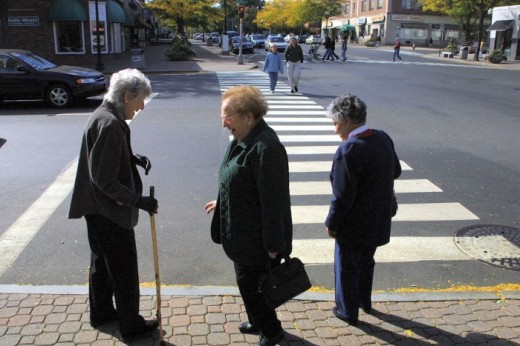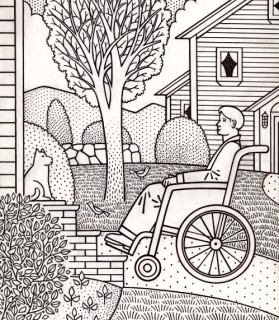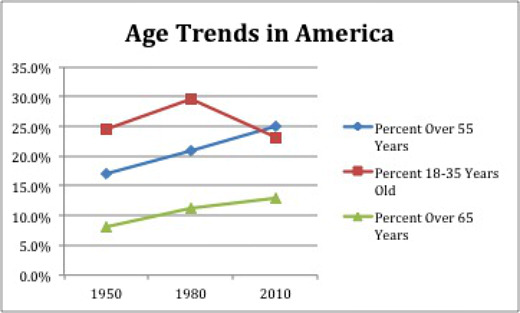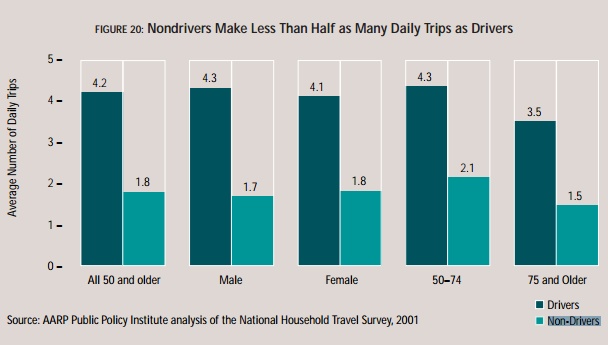with a response from Stuart Andreason
Editor’s Introduction: We’re excited to be introducing a monthly, year-long series focusing on issues facing both younger and older generations. Two talented individuals — Jennifer Wallace-Brodeur and Stuart Andreason — will be providing you with their perspectives. Jennifer is a senior advisor with AARP, while Stuart is a young planner and PhD student with a wide range of research interests (you’ve already heard from Stuart in two articles about “MOOCs”).
We hope you’ll engage in a discussion with the authors by using our LinkedIn group page. If you’re not a member, you can join LinkedIn at no charge and then participate in our group. Hope to see you there!
With Social Security and Medicare dominating our national political discourse, it’s easy to overlook the significant role local leaders will play in determining whether aging is a boom or a bust for residents of their community.
The age boom is now in full swing and the number of people over the age of 65 will increase dramatically over the next 20 to 40 years – as well as their share of the total population. By 2030, just 17 years from now, when the last of the baby boomers turn 65, the 65 and older population will have doubled from what it is today – to more than 70 million.
Accompanying this demographic shift is a cultural shift away from traditional notions of retirement and the lure of Sunbelt states. AARP research consistently shows 85 to 90 percent of people age 45 and older want to stay in their current home as well as their community for as a long as possible. 1  If a move is contemplated, it’s more likely driven by children and grandchildren, than climate.
If a move is contemplated, it’s more likely driven by children and grandchildren, than climate.
The overwhelming desire to “age-in-place” puts community leaders – elected officials, professional staff and citizen planners – front and center in responding to the evolving demographics of their communities.
To begin to get our arms around such a large issue, it’s important first to understand what outcomes we want for ourselves and for our community. With aging we know that most individuals hope to stay independent, connected and engaged with friends, family and the community for as long as possible. Isolation is what we are trying to avoid.
AARP research backs up what we know instinctively, that the more engaged and connected people are to their communities the more likely they are to report indicators of successful aging or high quality of life. For the community at large, facilitating and encouraging engagement of older residents is essential to economic and cultural vitality, volunteerism, and intergenerational connection.
With all of this in mind, there are three main areas of focus for strategies that support aging-in-place.
Transportation
One of the greatest concerns we all have as we grow older is the thought of giving up the car keys. Not only does it signal personal decline, but where there are limited options to driving, it can literally reduce a person’s contact with the world.
AARP research shows that non-drivers make half as many outings as drivers and 50 percent report missing out on things they’d like to do. 2
Public transit, safe streets and sidewalks, and volunteer driver programs are critical connectors for older residents.

Complete Streets policies are being adopted across the country (the 500th policy was just celebrated in Memphis) and are one way in which states and communities are shifting from a singular focus on cars and trucks to considering the needs of road users of all ages and abilities on the front end of transportation projects.

Housing
Affordable and accessible housing is inextricably connected to quality of life for older people. Policies and programs that help people stay in their current homes are highly important as are diverse housing options for those who want to downsize or move to where they can access more care.
Universal design and visitability policies are strategies aimed at improving the safety and utility of housing for all people, including older adults and people with disabilities.
Land Use
Coordinating land use, transportation, and housing policies is essential.
Too often senior housing is developed on the outskirts of town making it difficult for residents to get where they want to go.
Too often senior housing is developed on the outskirts of town making it difficult for residents to get where they want to go. Sidewalks required within developments often stop at the main road with no plan to build connections. Even when housing is located in more dense neighborhoods they may not be on a bus route, nor have adequate sidewalks, or safe street crossings.
Across the country, communities are slowly beginning to apply an “aging lens” to planning. While there is a range of ways in which to enter this work, the most successful communities start with a robust public engagement process to educate residents and policy makers and identify priorities.
AARP’s Network of Age-Friendly Communities, which is affiliated with the World Health Organization, provides a framework for planning, implementation and evaluation for aging strategies. Cities like New York, Philadelphia and Portland, Oregon have paved the way and now smaller cities like Wichita, Kansas and rural areas like Chemung County, New York are joining. Others such as Atlanta and Maricopa County, Arizona have developed their own models of engagement.
As you engage in this process it will become immediately evident that community strategies to support quality of life for older residents benefit people of all ages.
- Streets and sidewalks that work for 80 year olds also work for children walking to school and young parents with strollers.
- Housing that is connected to essential services is good for commerce and creates community vitality.
- Land use that supports physical activity contributes to the overall health of the community.
Being educated about how to address aging is important. At the end of the day, this work is about good community planning and design that will create great places for all ages.
Jennifer Wallace-Brodeur has been at AARP since 2005, serving as Associate State Director in the Vermont State Office until 2013, and then moving to the national office as Senior Advisor States. In Vermont, she led the Burlington Livable Community Project, which established a vision and action steps for Burlington to meet the needs of its aging population. This was one of AARP’s first local livable community projects. She also led AARP’s campaign to pass Complete Streets legislation in 2011, which earned her the Outstanding Service Award from the Vermont Planners Association.
Jennifer is active as a community volunteer, currently serving on the Burlington Planning Commission and previously as chair of the Burlington Electric Commission. In 2012, she was appointed to the Governor’s Commission on Successful Aging and served as chair of the livable communities subcommittee.
A Response from Stuart Andreason:
How important is planning for an aging population? Incredibly important! Jennifer notes that by 2030, the 65 and older population will be over 70 million people, which could be upwards of 20 percent of the entire population, but major demographic changes are already afoot.
Census data shows that America has already crossed an “aging milestone.” For the first time, there are more people over the age of 55 than the younger 18-34-year-old cohort. In just a few short years, the 55-year-old cohort will be over 65 and approaching retirement.

The macro-population trends are important to consider, but local community planners should consider their local population make up as well. Some communities may be significantly older or younger and, as Jennifer explains, the geography of population is very important for planning.
Jennifer also accurately observes that planning for an aging community is not a zero sum game. Good planning and community development can benefit everyone — young, old, and in between. In fact a number of studies show that young adults want many of the same planning considerations that Jennifer identifies including walkable neighborhoods served by transit, affordable housing in close knit communities, and a mix of uses and activities near their home. 3 Joseph Cortright outlines many of these desires in The Young and Restless in a Knowledge Economy. As the young cohort ages, they will probably carry their preferences with them. Sound planning for all ages will provide benefits into the future.
I believe that there may be a new “planning constituency” made up of young adults, empty nesters, and retirees.
I believe that there may be a new “planning constituency” made up of young adults, empty nesters, and retirees. Young people are delaying having children and the retiree and empty nester population is growing. These trends together make the “young” and “old” populations similar. While there are differences as well, I look forward to further exploring how communities can plan for the “young” and “old” in our upcoming articles.
Stuart Andreason is a doctoral candidate in the Department of City and Regional Planning at the University of Pennsylvania where he studies community and economic development. He previously researched civic innovation in community participation.
Prior to entering graduate school, Stuart worked as the Executive Director of a Main Street Organization, the Orange Downtown Alliance, in Orange, Virginia.
Notes:
- See “Home and Community Preferences of the Age 45+ Population” (AARP Research & Strategic Analysis, 2010). ↩
- “Beyond 50.05 – A Report to the Nation on Livable Communities Creating Environments for Successful Aging” (AARP, 2005). ↩
- For further reading on young adult lifestyle preferences, see Christopher Leinberger’s “New Generation Revives Old Urban Style,” Joseph Cortright’s “The Young and Restless in a Knowledge Economy,” and the recently released The End of the Suburbs: Where the American Dream is Moving by Leigh Gallagher. ↩

